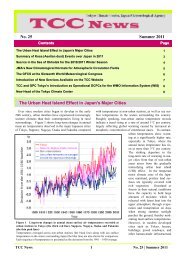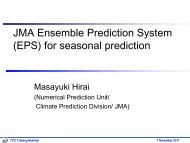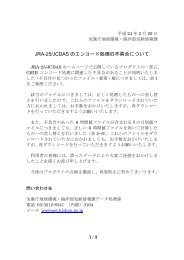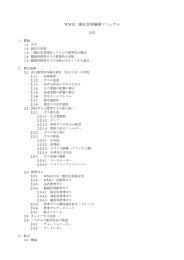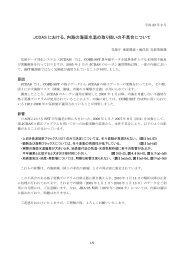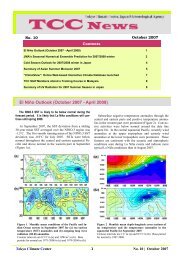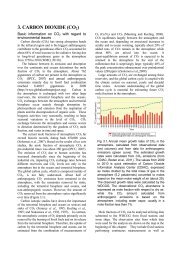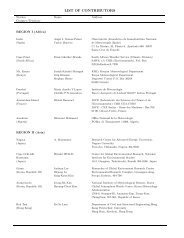TCC News No. 30
TCC News No. 30
TCC News No. 30
Create successful ePaper yourself
Turn your PDF publications into a flip-book with our unique Google optimized e-Paper software.
4. Prediction for the mid- and high latitudes of the<br />
<strong>No</strong>rthern Hemisphere (Figure 7)<br />
Around the Aleutian Low region, sea level pressure<br />
(SLP) anomalies (Figure 7(a)) are expected to be positive<br />
on the northern side and negative on the southern side,<br />
suggesting that the Aleutian Low will shift southward but<br />
its strength will be near normal. Conditions of the northwesterly<br />
winter monsoon are therefore expected to be near<br />
normal over East Asia. Negative anomalies of 500-hPa<br />
geopotential height (Figure 7(b)) are widely expected over<br />
the southern part of the Eurasian Continent, and this may<br />
(a)SLP (b)Z500 (c)T850<br />
-16 -12 -8 -4 0 4 8 12 16 -120 -90 -60 -<strong>30</strong> 0 <strong>30</strong> 60 90 120<br />
Figure 7 Predicted atmospheric fields from 20°N – 90°N for December 2012 – February 2013 (ensemble mean of 51 members)<br />
(a) Sea level pressure (contours) and anomaly (shaded). The contour interval is 4 hPa.<br />
(b) 500-hPa height (contours) and anomaly (shaded). The contour interval is 60 m.<br />
(c) 850-hPa temperature (contours) and anomaly (shaded). The contour interval is 3˚C.<br />
Category – 0 +<br />
<strong>No</strong>rthern Japan <strong>30</strong> 40 <strong>30</strong><br />
Eastern Japan 20 40 40<br />
Western Japan 20 40 40<br />
Okinawa and Amami 20 40 40<br />
Figure 8 Outlook for winter 2012/2013 temperature<br />
probability in Japan<br />
be attributable to active convection covering the area from<br />
the tropical Indian Ocean to Southeast Asia. Accordingly,<br />
lower-atmospheric temperatures are expected to be below<br />
normal over the mid-latitudes of the Eurasian Continent<br />
(Figure 7(c)). However, the prediction of negative anomalies<br />
around East Asia should be interpreted with caution<br />
because they may be affected by active convection over<br />
Southeast Asia, which is predicted with insufficient reliability.<br />
(Masayuki Hirai, Climate Prediction Division)<br />
-4 -3 -2 -1 0 1 2 3 4<br />
JMA’s Seasonal Ensemble Prediction System<br />
JMA operates a seasonal Ensemble Prediction System (EPS) using the Coupled atmosphere-ocean General Circulation Model<br />
(CGCM) to make seasonal predictions beyond a one-month time range. The EPS produces perturbed initial conditions by means of a<br />
combination of the initial perturbation method and the lagged average forecasting (LAF) method. The prediction consists of 51 members<br />
from the latest 6 initial dates (9 members are run every 5 days). Details of the prediction system and verification maps based on<br />
<strong>30</strong>-year hindcast experiments (1979 – 2008) are available at http://ds.data.jma.go.jp/tcc/tcc/products/model/.<br />
Cold Season Outlook for Winter 2012/2013 in Japan<br />
For winter 2012/2013, mean temperatures are likely to be<br />
above or near normal in eastern Japan, western Japan and<br />
Okinawa/Amami. Cold-season precipitation amounts are<br />
likely to be above or near normal in Okinawa/Amami.<br />
1. Outlook summary<br />
JMA issued its outlook for the coming winter over Japan<br />
in September and updated it in October. For winter<br />
2012/2013, mean temperatures are likely to be above or<br />
near normal in eastern Japan, western Japan and Okinawa/Amami<br />
with 40% probability for both categories (Figure<br />
8). Cold season precipitation amounts are likely to be<br />
above or near normal in Okinawa/Amami with 40%<br />
probability for both categories (Figure 9).<br />
Western<br />
Japan<br />
Okinawa/Amami<br />
Eastern<br />
Japan<br />
<strong>No</strong>rthern<br />
Japan<br />
<strong>TCC</strong> <strong>News</strong> 4 <strong>No</strong>. <strong>30</strong> | Autumn 2012



